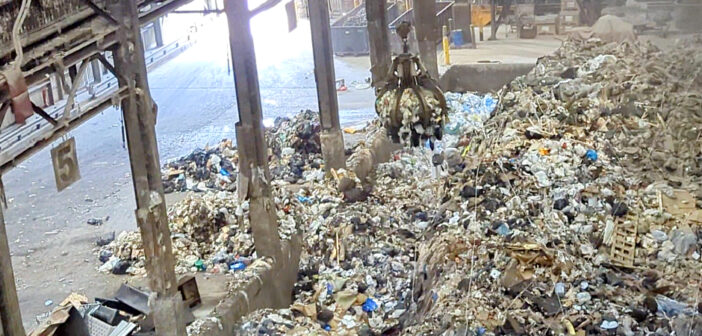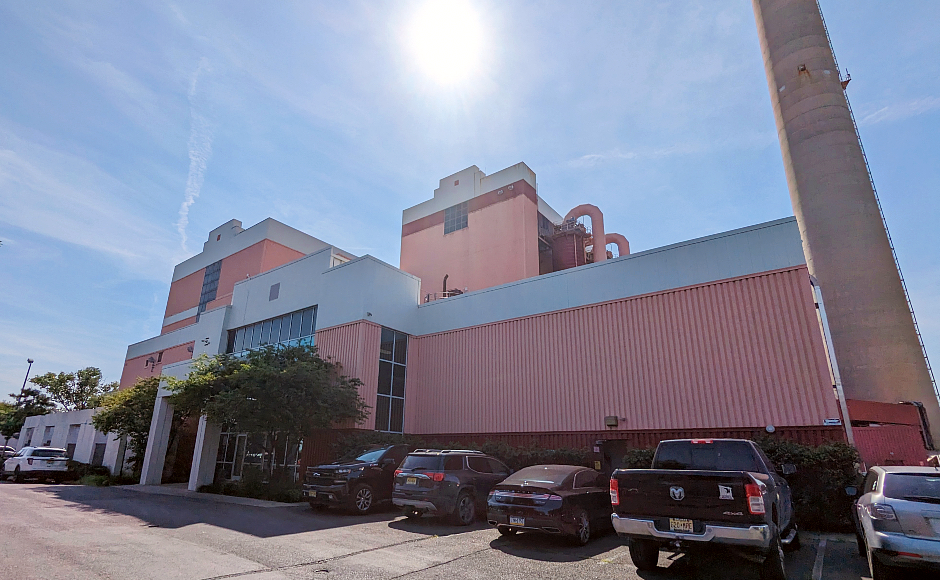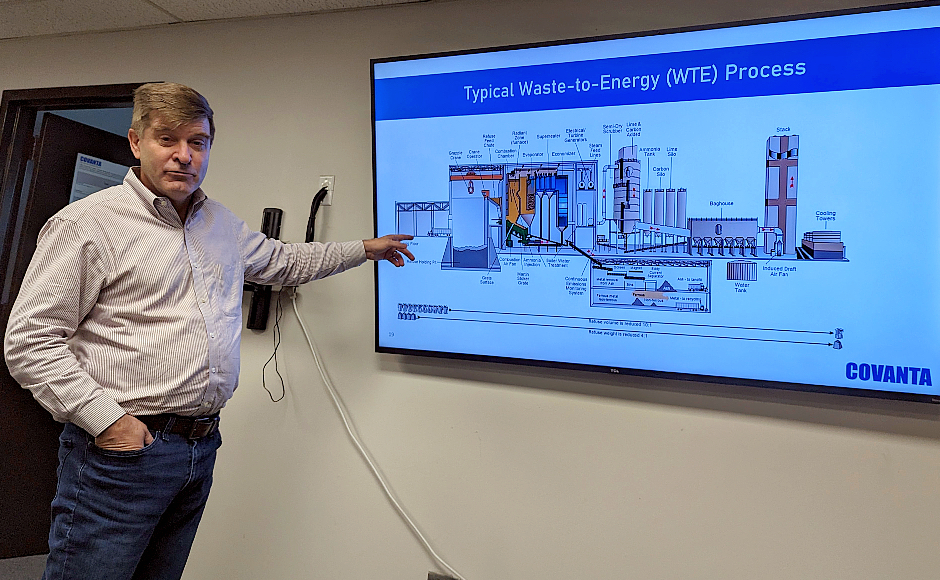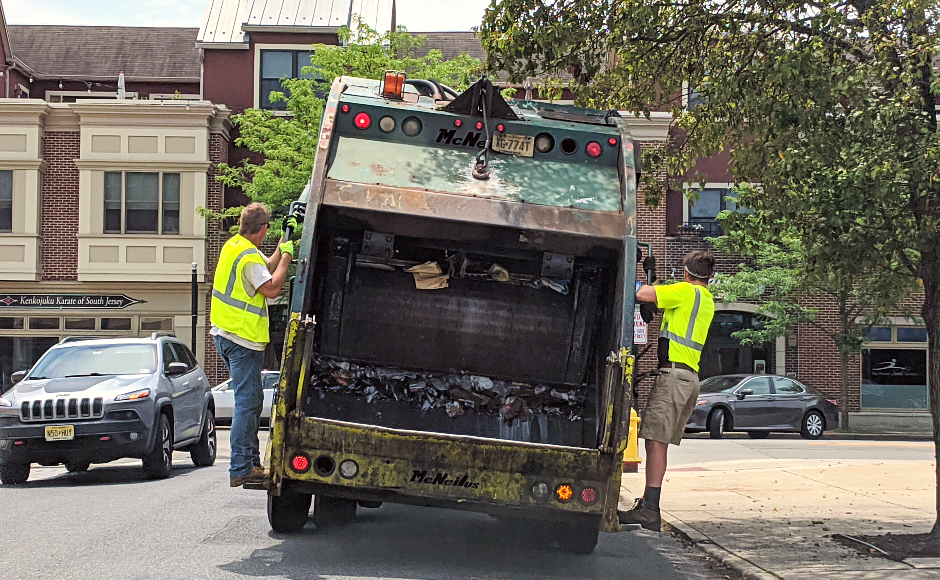Covanta will continue to manage solid waste for 24 Camden County municipalities at its Camden City incinerator. No one else has bid on the job since 2012. Residents produce tons of trash daily, and emissions from burning them remain an air-quality issue.
By Matt Skoufalos | December 28, 2023
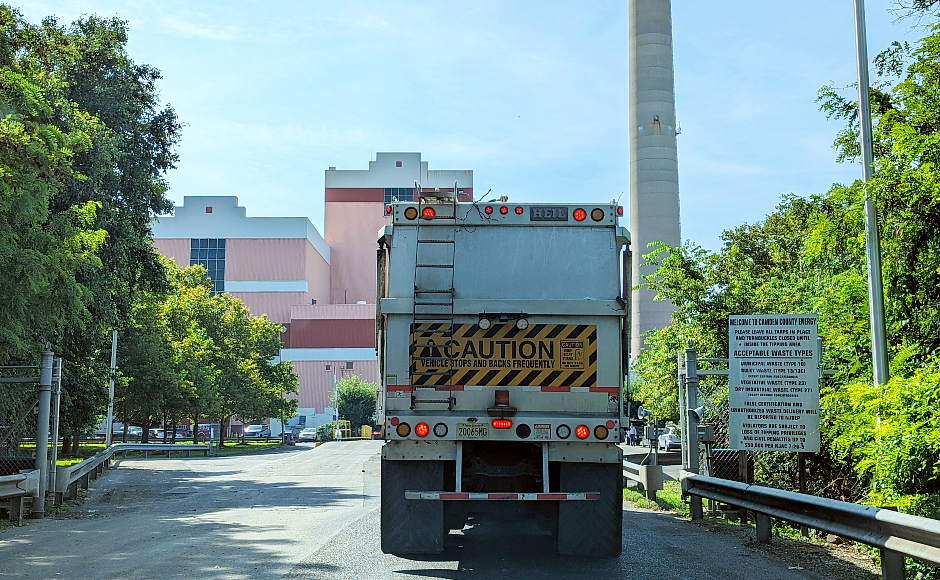
Trash truck waiting to be admitted to the Covanta incinerator site in August 2023. Credit: Matt Skoufalos.
After Camden County residents are done ringing in the New Year this weekend, they’ll start the first week of 2024 with their garbage and recycling being picked up as normal.
Although that’s what every taxpayer in the county would say they’d expect of their local and county governments, it almost wasn’t the case.
As the clock was winding down on 2023, so, too, was the county’s group purchasing agreement for disposing of its solid waste.
Since 2012, that work has gone to Camden County Energy Recovery Associates (CCERA), operators of the Covanta incinerator in Camden City.
The current contract covered trash disposal for 24 of the 36 Camden County municipalities, and for much of 2023, no one, not even Covanta, was bidding on the job again. Finally, after re-bidding the work in September, the county government received one submission of interest.
It was from CCERA, and at a 20 percent reduction over its previous bid. In November, the Camden County government awarded the contract to CCERA: a three-year deal, with two one-year renewal options.
Those communities participating in the group purchasing agreement will pay $92 per ton for the disposal of their solid waste at the Covanta incinerator; a figure that Camden County Commissioner Jeffrey Nash said ensures that “the towns will have a place to dump their trash without raising costs.”
That the issue was resolved so cleanly was “stunning,” the commissioner said.
“I was enormously surprised to see this,” Nash said. “At the end of the day, no one bid, with the exception of Covanta, and that’s the third time that happened.”
As unpalatable as it might be to continue burning solid waste and dealing with the emissions outflow of that approach, the broader issue for the region is that better — or any — alternatives simply may not exist.
“It’s a complicated issue because first, we have to make sure that the towns have a place to remove their trash at a reasonable cost without burdening taxpayers even more,” Nash said. “At the same time, the county is grappling with air quality issues, and that’s a serious problem.”
‘The elephant in the room’
Environmental justice advocates have long objected to the strategy of burning solid waste on the grounds that emissions from the waste-to-energy facility contribute significantly to overall air quality issues in the region, and public health conditions that follow from them.
Sean Mohen, executive director of Tri-County Sustainability, which coordinates municipal sustainability efforts among communities in Camden, Burlington, and Gloucester Counties, points to substandard air quality reports from the American Lung Association for the region dating back years.
In 2021, the ALA rated air quality in Camden and Gloucester Counties an “F”; Burlington County, which has no air monitoring processes in place, received no grade. In the most recent calculus, Camden earned a “D”, and Gloucester a “C,” with Burlington County again not receiving any report for the same lack of monitoring infrastructure.
“A lot of industrial pollution from Philly affects us over the border,” Mohen said, citing prevailing winds that blow east from Pennsylvania, vehicle emissions from nearby major highways, and “stationary industrial sources.”
Despite efforts from the state and federal governments to incentivize the electrification of fleet vehicles and individual cars, vehicle emissions are simultaneously the biggest airborne polluters, and the toughest challenge for environmentalists to wrangle.
Following that, however, “the elephant in the room is always the Covanta incinerator,” Mohen said.
“We want to ultimately reduce dependency on the incinerator,” he said.
Changing consumer behaviors that would result in less trash sent to CCERA is an ideal solution, albeit one that advocates and elected officials believe is exceptionally difficult to manage.
Alternatively, environmental advocates have asked Covanta to make a series of emissions reduction improvements to the Camden City facility, which the company calls its Camden Green Initiative.
These include an upgraded baghouse, an electrostatic collection and filtration system that would reduce heavy metals emissions there; a high-efficiency dry recirculating ash system that cuts acid gas; and improvements to its selective non-catalytic reduction (SNCR) system, which controls nitrogen oxide emissions. The life expectancy of those improvements is 20 years, Covanta said.
The challenge is that to offset the cost of those upgrades — an estimated $60 million — the company is requesting permission from the state Department of Environmental Protection (NJDEP) to facilitate a new line of business in Camden City: processing liquid industrial waste.
“If they approve it, according to our experts, the consequences are that it doesn’t add harmful contaminants to the emissions, and it would lead to a baghouse that would reduce harmful emissions,” Nash said. “But there would be more burning, which means more pollutants coming out of the stack; but still – more pollutants.
“There’s no right answer to this,” the commissioner said; “there are just choices.”
View this post on Instagram
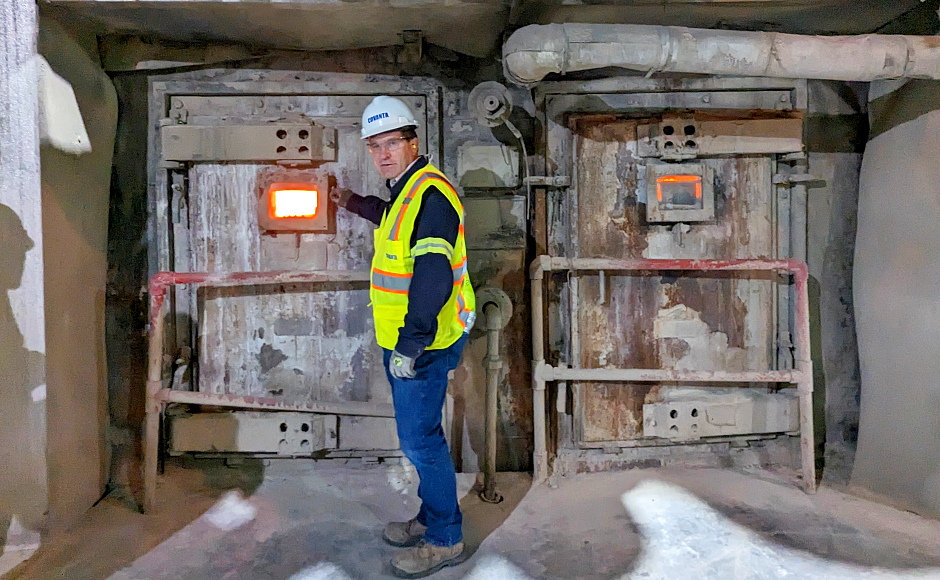
Covanta employee Jack Frace at the furnace viewing window in the Camden City facility. Credit: Matt Skoufalos.
Feeding the boilers
To tour the Covanta facility itself is to get a sense of the ominously unending stream of trash that the facility processes.
Garbage trucks from communities throughout Camden County pour in steadily throughout the day, dumping waste into a 20-foot pit some 3,000 to 7,000 tons at a time.
The facility does not pre-sort for recyclables, which means a lot of that kind of material is included in the piles.
Several stories above the tipping floor, a crane feeds trash into a refuse chute. The waste burns at 1,200 to 2,000 degrees, and that combustion creates high-pressure, high-temperature steam, which powers a turbine generating 25 megawatts (MW) per hour. The facility itself operates on 3 MW, and the remaining 22 MW can be sold back to the local electricity grid.
“We’re not here to make power; that’s just a byproduct of how we manage the trash,” CCERA Facility Manager Todd Frace said, “but we make enough to power about 60 percent of the city of Camden.”
Processing the trash in this fashion reduces it 90 percent by volume, and 80 percent by weight, Frace said. Four percent of the tonnage is ferrous metals, about 15,000 tons of which the facility recycles annually. The resultant ash is frequently sent to landfills, which are required to cover their buried trash with six inches of soil to prevent flyaway and intrusion, Frace said.
Presently, CCERA manages its heavy metal emissions by treating the ash from the incinerator with a limestone-and-water slurry and an activated carbon filtration system. The new baghouse system would retrofit the plant with a fully dry recirculating system that reduces emissions by giving that limestone reagent a longer retention time.
“Suck the air in, the bags catch the dust, the clean air comes out,” Frace said. “It’s the same principle as a vacuum cleaner.”
Although some European facilities are built with recirculating ash systems, the only plant in North America that had one installed from the ground up was Covanta Durham York, in Courtice, Ontario, Canada, Frace said. CCERA would be the first plant in North America to be retrofitted with it, he said.
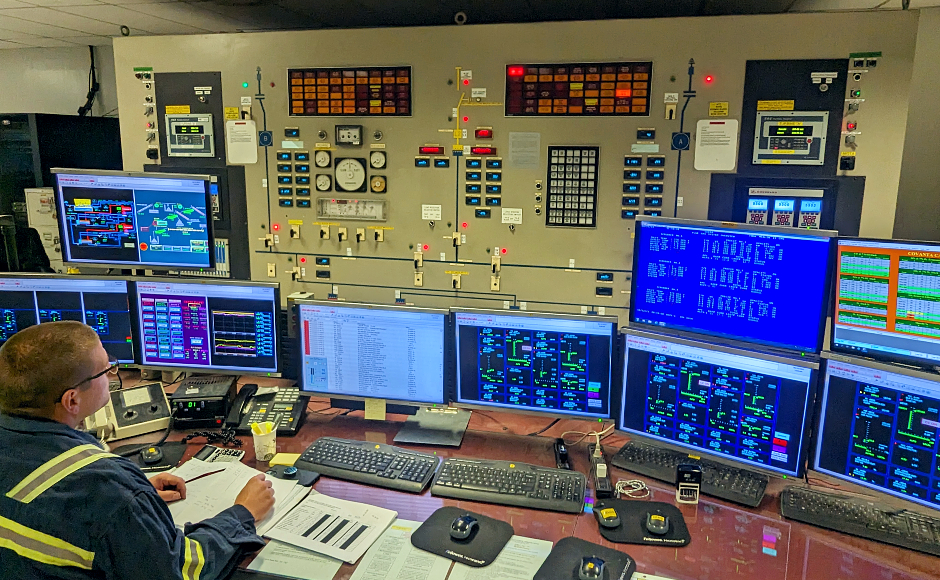
Covanta employees measure energy generation and emissions output at their Camden City facility. Credit: Matt Skoufalos.
However, Covanta maintains that in order to absorb the cost of the green initiative, it would need permission to take on a new line of business — namely, processing industrial liquid waste.
Frace described the kind of materials the site would process as things that can’t be sent through wastewater treatment facilities because they would kill the beneficial bacteria used there: things like the cleaning materials used in tank rinses and line flushes from industrial food and beverage producers; adhesives, coatings, latex paint, nutrition products, and pharmaceuticals.
The facility would not process liquified natural gas or fracking runoff, landfill leachate, grease trap cleanout, used oil, pesticides, fungicides, septic tank waste, sewage, or per- and polyfluoroalkyl substance (PFAS) liquids, he said. Covanta has operated comparable systems in Niagara, New York; Indianapolis, Indiana; and Oxford Township in Warren County, New Jersey.
“We originally hoped to have this system operational by 2026,” Frace said. “Before we can do a project like this, we have to hold meetings, talk to the public, and respond to their comments.
“Last year we did a host of community meetings,” Frace continued. “We had a public meeting in December last year, and had 900 pages of comments. It’s taken us until now to get the answers. That’s what’s driving the timeframe of the whole project.”
Given the review time for NJDEP to process public comments about the project, any such system won’t be operational until 2027, Frace said — and that’s if it’s approved.
In the meantime, the company publishes continuous emissions monitoring systems (CEMS) data on its website daily, and continues to seek opportunities to connect with the public, including through local community benefit agreements (CBA) and sustainability outreach.
“We want to have open, two-way communication with communities,” Frace said.
Nonetheless, the biggest concern remains the volume of waste produced in the county daily, and the limited options available for its disposal.
On average, every American makes about five pounds of waste per day, the most in the world; multiplied by some half-a-million Camden County residents, the scale of the challenge becomes clearer.
Whether waste is burned or sent to a landfill, it must be removed, and cutting compostable material out of the system could have a significant impact on the size of that task.
“I think a lot of times people want to say we don’t need waste-to-energy plants, but we need to find sustainable ways to dispose of the waste,” Frace said.
“I think there’s a misconception that we want to burn everything, and we don’t,” he said. “At all of our plants, we really are looking at how we can reduce any impact that we can have on the community.”
At the same time, Frace noted that there is “no agency or law or rules change that compels installation” of the system upgrades contemplated in the Camden Green Initiative; neither, Nash noted, does the county “have a legal obligation to find the place for all of its towns to take out its trash.”
Just as the localized impact of waste emissions is disproportionately felt by communities downwind of the incinerator, so too do the challenges of paying for waste removal constitute environmental justice issues of a kind for smaller municipalities that already struggle with the cost of government operations.
Although larger Camden County communities like Cherry Hill, Gloucester Township, Somerdale and Winslow have their own contracts for trash removal, the smaller communities participating in the group purchasing agreement “are relying on the county to figure it out,” Nash said.
“The big towns have options,” Nash said; without the three-year contract extension, “the smaller towns, particularly those along the White Horse Pike, would have had problems.”
“[Covanta] are good community partners, but they are saddled with a business that no one likes,” the commissioner said. “I am just sitting here very grateful that they came in with a bid that allows us to empty the trash starting January 1.”
In order to more conclusively affect the emissions problem, Nash said that individual households and businesses need to find ways to cut the waste they send to the curb, particularly organic materials.
At the same time, he acknowledged that, without the infrastructure to do so — which most comfortably exists in suburban towns where people can house composters on their properties — it becomes an individual challenge.
“How do you do it in some of the tightly knit, tightly housed communities?” the commissioner said. “Someone has to pay to pick [organic waste] up. Is the municipality going to add that cost to their municipal budget when they’re already full to the brim? And where does it go?
“Right now, we don’t have answers to these two questions,” Nash said.
Please support NJ Pen with a subscription. Get e-mails, or follow us on Facebook, Twitter, and Instagram.

